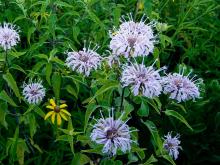Wildflowers, Grasses and Other Nonwoody Plants
Media

Species Types
Scientific Name
Viola bicolor
Description
Johnny-jump-up is a flat-faced violet whose small flowers are a washed-out blue or violet with a very light yellow or white center. Look for it in fields, meadows, glades, rights-of-way, disturbed sites, and possibly your front lawn.
Media

Species Types
Scientific Name
Astragalus crassicarpus (formerly A. mexicanus)
Description
Ground plum is a legume that bears plumlike, edible fruits. Its short, spikelike clusters of pea flowers can be white, cream, yellow, pink, or violet.
Media

Species Types
Scientific Name
Tradescantia ohiensis
Description
Smooth spiderwort is the most common and widely distributed of Missouri's spiderworts. It has slender, straight or zigzag stems. The long, narrow leaves are folded lengthwise and attach to the stem in a thick node. The 3 petals of the triangular flower are blue, rose, purple, lavender, or white.
Media

Species Types
Scientific Name
Ipomoea pandurata
Description
Wild potato vine is related to the sweet potatoes we buy at grocery stores. This native vine is also related to the morning glories that decorate trellises and to the bindweed that plagues gardeners and farmers.
Media

Species Types
Scientific Name
Daucus carota
Description
Queen Anne’s lace is many things to many people — roadside wildflower, noxious introduced weed, wild edible, medicinal herb, delightful cut flower. In Missouri, it blooms May through October.
Media

Species Types
Scientific Name
Trifolium pratense
Description
Red clover, or purple clover, is the familiar large, pinkish-purple clover that grows in lawns, pastures, and roadsides statewide. A Eurasian native, it was introduced to North America by the middle 1600s.
Media

Species Types
Scientific Name
Monarda fistulosa
Description
Sometimes called beebalm, wild bergamot (or horsemint) is a native mint with a long history as a valued Missouri herb. Some people make tea from it, but most of us enjoy its large, colorful flowers.
See Also
About Wildflowers, Grasses and Other Nonwoody Plants in Missouri
A very simple way of thinking about the green world is to divide the vascular plants into two groups: woody and nonwoody (or herbaceous). But this is an artificial division; many plant families include some species that are woody and some that are not. The diversity of nonwoody vascular plants is staggering! Think of all the ferns, grasses, sedges, lilies, peas, sunflowers, nightshades, milkweeds, mustards, mints, and mallows — weeds and wildflowers — and many more!





















